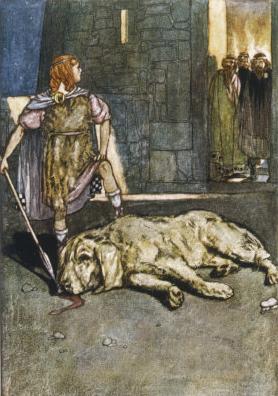Cú Chulainn facts for kids
Cú Chulainn (pronounced Koo HOO-lin), also spelled Cúchulainn, is a famous hero from Irish mythology. He is like a demigod, appearing in many stories from the Ulster Cycle. You can also find tales about him in Scottish mythology and on the Isle of Man.
Many believe Cú Chulainn is the son of the Irish god Lugh. His mother was a human named Deichtine, who was the sister of King Conchobar mac Nessa.
Contents
How Cú Chulainn Got His Name
Cú Chulainn was born with the name Sétanta. He got his more famous name when he was just a child.
The Hound of Culann
One day, young Sétanta accidentally killed a fierce guard dog belonging to a blacksmith named Culann. He did this in self-defense. To make up for it, Sétanta offered to take the dog's place. He would guard Culann's home until a new guard dog could be trained. Because of this brave act, he became known as Cú Chulainn, which means "Hound of Culann."
Cú Chulainn's Great Deeds
Cú Chulainn was known for his amazing strength and bravery. He was a true hero.
Defending Ulster
When he was only seventeen years old, Cú Chulainn bravely defended his home, Ulster, all by himself. He fought against the armies of Queen Medb of Connacht. This famous battle is told in the story called Táin Bó Cúailnge, which means "The Cattle Raid of Cooley."
The Battle Frenzy
Cú Chulainn was known for something called a ríastrad (pronounced REE-as-trad), or "battle frenzy." When he entered this state, he would become a terrifying, unrecognizable warrior. He would fight with incredible power, not caring who was friend or foe.
His Chariot and Horses
In battle, Cú Chulainn fought from his chariot. It was driven by his loyal friend and charioteer, Láeg. His chariot was pulled by two famous horses, Liath Macha and Dub Sainglend.
Similar Heroes in Other Cultures
Cú Chulainn's story has some interesting similarities to heroes from other parts of the world. For example, he is a bit like Rostam, a legendary hero from Persia. He also shares traits with heroes from Germanic stories and even the Greek hero Heracles. This suggests that some heroic tales might have very old, shared roots across different cultures.
Images for kids
-
"Cúchulainn rebuked by Emer", illustration by H. R. Millar from Charles Squire, Celtic Myths and Legends, 1905
See also
 In Spanish: Cúchulainn para niños
In Spanish: Cúchulainn para niños








